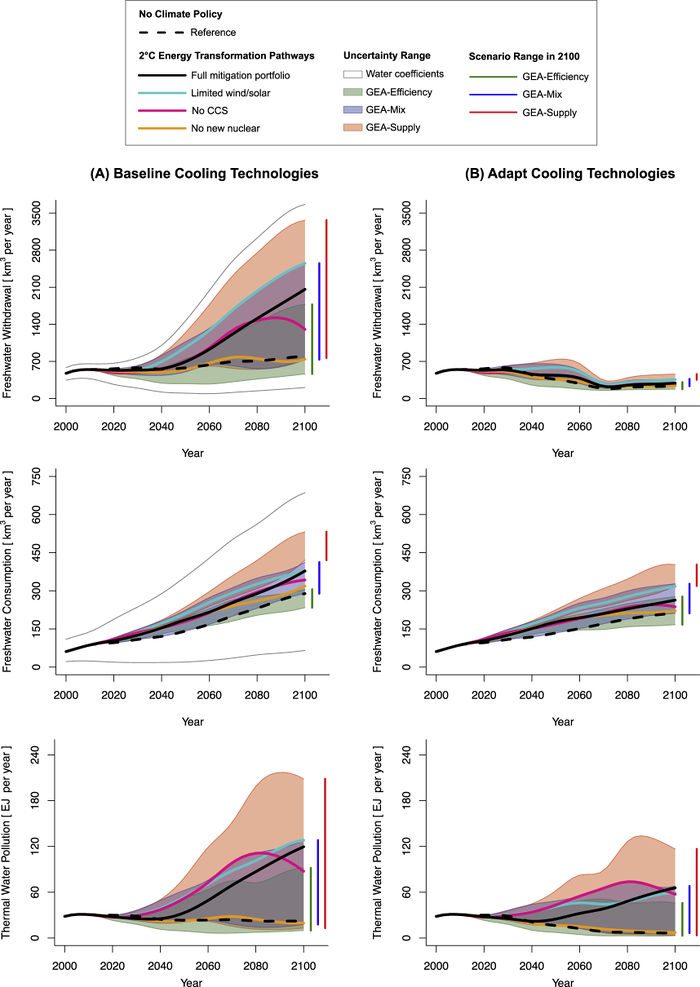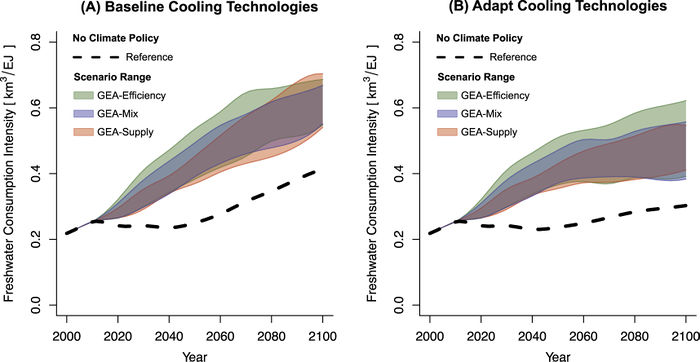Water - MESSAGE-GLOBIOM
| Corresponding documentation | |
|---|---|
| Previous versions | |
| Model information | |
| Model link | |
| Institution | International Institute for Applied Systems Analysis (IIASA), Austria, http://data.ene.iiasa.ac.at. |
| Solution concept | General equilibrium (closed economy) |
| Solution method | Optimization |
| Anticipation | |
Large amounts of water are currently being used in the energy sector. For assessing long-term freshwater sustainability, MESSAGE has been adapted to quantify the impact of energy system transformations on water.
The majority of energy sector freshwater withdrawal occurs in the steam-cycle and cooling systems related to thermoelectric power plants. The model distinguishes between two different water-cooling technologies, but also a technology only using air for cooling purposes, which provide an opportunity to reduce energy system reliance on water. The different technologies that are therefore distinguished in the model are:
- Once-through cooling technology: water is passed through the cooling system once and then returned to its source.
- Closed-loop cooling technology: water that is withdrawn is re-circulated.
- Air-cooling technology: instead of water, air is used for cooling purposes.
Further, the water source is distinguished across technologies between fresh or saline.
This choice of model formulation enables consistent representation of water use across power plant types and incorporates water impacts of heat-rate improvements due to anticipated long-term technological change. Moreover, the approach enables analysis of thermal water pollution from once-through cooled thermal power plants by allowing quantification of the heat energy embodied in cooling system effluents.
When applied to a broad range of climate mitigation scenarios that aim for 2 degrees Celsius, the results show a wide range of water implications across scenarios. Global demand of freshwater is expected to grow in all 2 degree scenarios due to rapidly growing electricity demand in many developing countries as a result of and the prevalence of freshwater-cooled thermal power generation. However, a shift to water-efficient cooling technologies can significantly reduce the use of water within the energy sector by reducing the freshwater withdrawals and thermal pollution related to thermoelectric power production. Further, controlling demand is another strategy that can reduce the water use, and further, it provides more flexibility in terms of cooling technology choices for thermoelectric power plants. Therefore, an integrated approach, using both technology adaptation and demand control, is seen as the most effective and flexible approach to reducing water demand in the energy sector. (Fricko et al, 2016MSG-GLB_fricko_energy_2016)
<xr id="fig:MESSAGE-GLOBIOM_water1"/> presents the impact of water usage across different 2 degree scenarios from the Global Energy Assessment (GEA), and how adopting technologies can help reduce the water demand.
<figure id="fig:MESSAGE-GLOBIOM_water1">

</figure>
Water consumption is responsive to the energy demand level, as depicted in <xr id="fig:MESSAGE-GLOBIOM_water1"/>. <xr id="fig:MESSAGE-GLOBIOM_water2"/> explores the relationship between energy demand and water use by computing the water consumption intensity of the energy pathways (global water consumption divided by final energy demand). The intensity of water consumption increases over the simulation period regardless of the demand level. The GEA-Efficiency scenarios display the largest range of water since low demand levels permit a greater flexibility in supply side technologies for climate change mitigation. (Fricko et al, 2016MSG-GLB_fricko_energy_2016)
<figure id="fig:MESSAGE-GLOBIOM_water2">

</figure>